Blog
Conquering the Itch: Understanding and Managing Urticaria (Hives)

Introduction:
Urticaria, also commonly known as hives, is a skin condition that causes itchy, raised welts to form on the skin. These welts, or wheals, can vary in size and shape, and they can appear anywhere on the body.
Hives are a very common condition, affecting up to 20% of people at some point in their lives.
Urticaria can be acute or chronic. Acute urticaria last for less than six weeks, while chronic urticaria last for more than six weeks. In most cases, hives are not serious and will go away on their own within a few days. However, some cases of hives can be a sign of a more serious medical condition, such as an allergic reaction or an autoimmune disease.
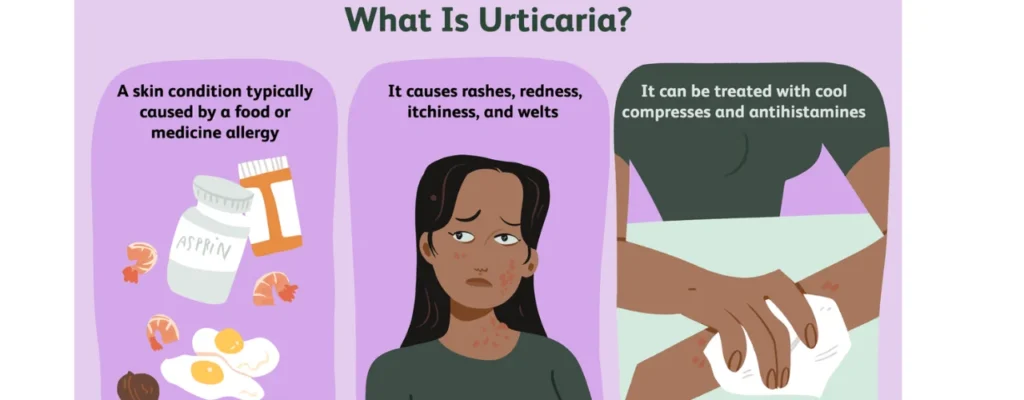
If you develop urticaria, it is important to see a doctor to determine the cause of your hives and to get the appropriate treatment. Treatment for hives will vary depending on the underlying cause. In some cases, no treatment is necessary and the hives will go away on their own. In other cases, medications, such as antihistamines or corticosteroids, may be needed to relieve the itching and swelling.
Causes of urticaria:
There are many potential causes of urticaria, or hives, and they can be broadly categorized into a few main groups:
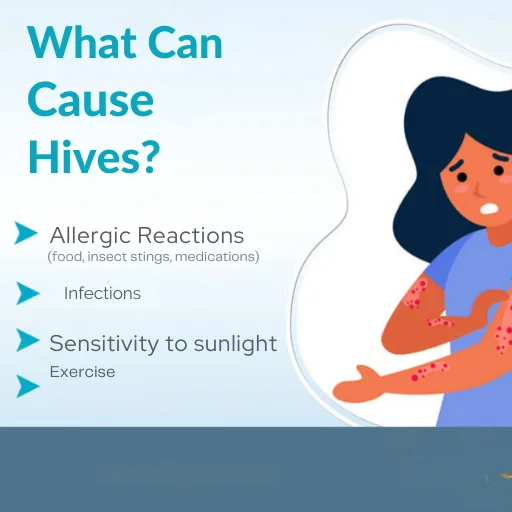
1. Allergic Reactions:
- Foods: Common culprit foods include peanuts, eggs, nuts, shellfish, fruits (especially strawberries), milk, and some grains.
- Medications: Antibiotics (penicillin and sulfa drugs), aspirin, ibuprofen, and some other medications can trigger hives.
- Insect stings/bites: Bee stings, wasp stings, and bites from certain bugs can induce hives.
- Latex: Exposure to latex gloves, balloons, or other latex products can cause hives in some people.
2. Physical Stimuli:
- Pressure: Tight clothing, friction from rubbing, or even holding something heavy can trigger hives in some individuals.
- Temperature: Exposure to extreme heat or cold, sun exposure, or even hot showers can cause hives.
- Vibration: Some people develop hives due to exposure to vibrating tools or machines.
- Water: In rare cases, contact with water, especially cold water, can trigger hives.
3. Infections:
- Viral infections: The common cold, mononucleosis, hepatitis, and other viral infections can cause hives.
- Bacterial infections: Urinary tract infections, strep throat, and other bacterial infections can sometimes trigger hives.
4. Other Mechanisms:
- Autoimmune diseases: Lupus, rheumatoid arthritis, and some other autoimmune conditions can involve skin manifestations like hives.
- Internal illnesses: Some internal diseases like thyroid problems, liver disease, and cancers can rarely cause hives.
- Stress: Emotional stress can trigger hives in some people.
- Exercise: In some cases, exercise can induce hives, sometimes called “cholinergic urticaria.”
5. Idiopathic Hives:
In some cases, the exact cause of hives cannot be determined and is called idiopathic urticaria. This accounts for roughly 10% of all hives cases.
Symptoms of urticaria:
Urticaria, commonly known as hives, is characterized by several key symptoms:
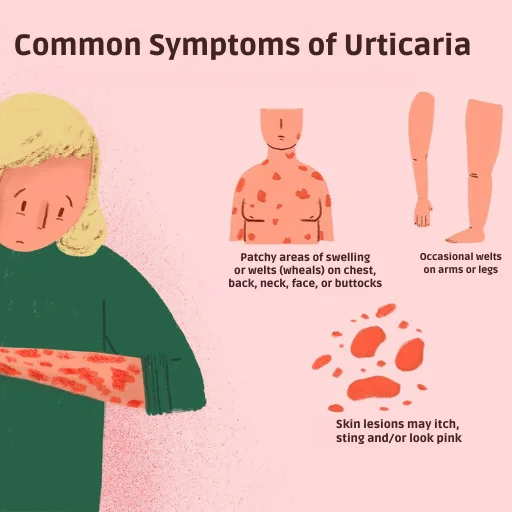
1. Itchy, raised welts (wheals): This is the hallmark symptom of urticaria. Wheals are generally red or skin-colored bumps with well-defined edges and can vary in size, ranging from a pinhead to a dinner plate. They often have pale centers when pressed (blanching).
2. Itching: The intense itching associated with hives is typically described as burning, stinging, or prickling. Scratching can worsen the itching and even lead to increased swelling and infection.
3. Swelling: In some cases, hives can cause swelling beyond the raised welts, particularly around the lips, eyes, throat, or hands. This swelling, known as angioedema, can be more concerning as it may affect breathing or swallowing.
4. Appearance and disappearance: Unlike most rashes, hives are known for their rapid appearance and disappearance. They can develop suddenly within minutes or hours and typically fade within 24 hours, although some may last longer. New hives may appear while older ones fade, creating a shifting pattern.
5. Additional symptoms: While less common, urticaria can be accompanied by other symptoms like fatigue, headache, nausea, joint pain, or fever. These symptoms may suggest a more underlying issue associated with the hives.
Important differences from other skin conditions:
- Bug bites: Hives often come and go quickly unlike bug bites, which typically persist and have a central puncture mark.
- Eczema: Eczema causes dry, itchy patches of skin, not the raised welts characteristic of hives.
- Psoriasis: Psoriasis presents with thick, red, scaly patches, not the smooth, itchy welts of hives.
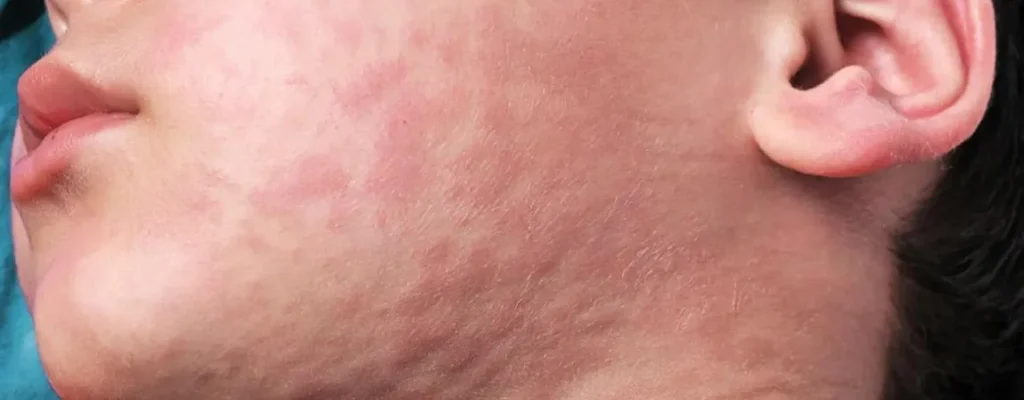
Remember: While hives are usually harmless and resolve on their own, it’s crucial to seek medical attention if you experience:
- Difficulty breathing or swallowing due to swelling around the throat or face
- Dizziness or lightheadedness
- Severe abdominal pain or vomiting
- Hives lasting longer than six weeks (chronic urticaria)
- Any concerning or worsening symptoms
Seeking medical help allows for proper diagnosis and appropriate treatment based on the cause of your urticaria.
Types of urticaria:
There are many different types of urticaria, each with its own specific cause and symptoms. Here are some of the most common types:
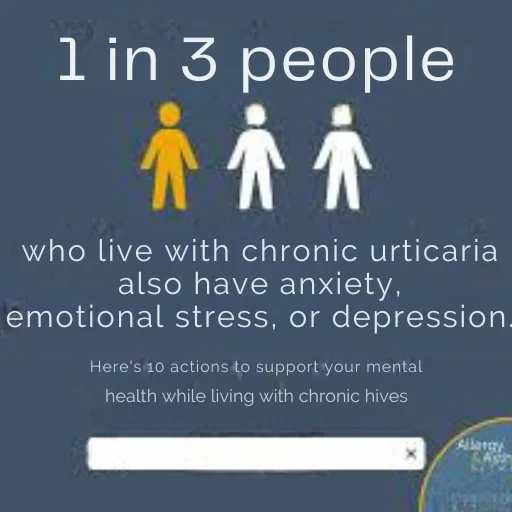
Acute urticaria:
- This is the most common type of hives, lasting less than six weeks.
- It is often caused by allergic reactions to food, medications, or insect bites.
Chronic urticaria:
- This type of hives lasts for more than six weeks and can be caused by a variety of factors, including autoimmune diseases, infections, and certain medications.
Physical urticaria:
- This type of hives is triggered by physical factors, such as pressure, heat, cold, sun exposure, or vibration.
- Dermographism: This is a common type of physical urticaria that is caused by stroking or scratching the skin.
- Cold urticaria: This type of hives is caused by exposure to cold temperatures.
- Heat urticaria: This type of hives is caused by exposure to hot temperatures.
- Solar urticaria: This type of hives is caused by exposure to sunlight.
- Aquagenic urticaria: This rare type of hives is caused by contact with water.
Cholinergic urticaria:
- This type of hives is caused by increased body temperature, such as during exercise or sweating.
Papular urticaria:
- This type of hives is characterized by small, itchy bumps that often appear after insect bites.
Pigmented urticaria:
- This rare type of hives is characterized by brown or purple patches on the skin.
Autoimmune urticaria:
- This type of hives is caused by the immune system attacking the body’s own tissues.
Treatment of urticaria:
Treatment for urticaria, commonly known as hives, depends largely on the type and underlying cause. Here’s an overview of the main approaches:

1. Identifying the cause:
The first step is always to identify the trigger or cause of your hives. This might involve allergy testing, keeping a diary of potential triggers, and undergoing additional examinations. Knowing the cause helps guide the most effective treatment plan.
2. Avoiding triggers:
Once the triggers are identified, the most important management strategy is to avoid them as much as possible. This may involve dietary changes, avoiding certain medications, taking precautions against insect bites, or adjusting clothing habits for physical urticaria.
3. Medications:
- Antihistamines: These are the first-line medication for most types of urticaria. They work by blocking histamine, a chemical in the body that causes itching and swelling. Both over-the-counter and prescription options are available, and choosing the right one depends on the severity and duration of your hives.
- Corticosteroids: In severe cases or for short-term relief, oral or topical corticosteroids may be prescribed to reduce inflammation and itching. However, long-term use of corticosteroids is not recommended due to potential side effects.
- Other medications: Depending on the specific type of urticaria, other medications like leukotriene antagonists, immunosuppressants, or omalizumab (a biologic agent) might be considered.
4. Home remedies:
- Cool compresses: Applying cool compresses to the affected areas can help soothe itching and reduce swelling.
- Calamine lotion: This over-the-counter lotion can also provide temporary relief from itching.
- Loose clothing: Wearing loose, breathable clothing made from natural fabrics can help prevent irritation and make you feel more comfortable.
- Stress management: Stress can sometimes worsen urticaria symptoms, so managing stress through relaxation techniques like yoga or meditation might be helpful.
5. Emergency situations:
If you experience any worrying symptoms like difficulty breathing, wheezing, dizziness, or swelling of the throat or face, seek immediate medical attention as these could be signs of a serious allergic reaction or angioedema.
Remember:
- Always consult a dermatologist for diagnosis and treatment of urticaria.
- Treatment effectiveness varies depending on the type and cause.
- Avoiding triggers is crucial for managing the condition.
- Be aware of emergency symptoms and seek help immediately if needed.
Prevention of urticaria:
While urticaria, or hives, can be unpredictable and sometimes arise without a clear trigger, there are definitely steps you can take to try and prevent them:
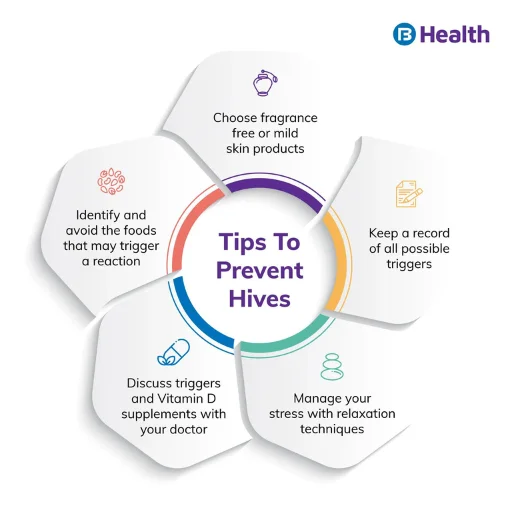
1. Identify and avoid triggers:
- Allergy testing: This can help pinpoint sensitivities to food, medications, or environmental allergens. Once identified, avoiding those triggers becomes key in preventing hives.
- Keep a diary: Track your activities, food intake, and environmental exposures around episodes of hives. This can help identify patterns and potential triggers.
2. Manage underlying conditions:
- Treat infections: Certain infections can trigger hives. Promptly treating any underlying infections may help prevent hives outbreaks.
- Address autoimmune conditions: If you have an autoimmune condition known to contribute to hives, managing it effectively can reduce the risk of episodes.
3. Proactive general measures:
- Healthy lifestyle: Ensure adequate sleep, manage stress through relaxation techniques, and maintain a balanced diet rich in fruits, vegetables, and whole grains. These healthy habits can strengthen your immune system and potentially reduce overall susceptibility to hives.
- Medications: In some cases, your doctor may recommend preventive medication like low-dose antihistamines, especially if you have chronic urticaria or frequent recurrent episodes.
- Sun protection: Use sunscreen regularly if you’re susceptible to solar urticaria.
- Cool showers: Opt for cool showers or baths instead of hot water which can aggravate certain types of hives.
- Loose clothing: Avoid tight-fitting clothing and opt for loose, breathable fabrics like cotton to minimize friction and irritation.
4. Manage physical triggers:
- Dermographism: If you have this type triggered by scratching, wear soft clothing and avoid activities that could lead to friction on your skin.
- Pressure urticaria: Opt for supportive footwear and minimize carrying heavy objects to avoid pressure-induced hives.
- Cold urticaria: Dress warmly and take precautions in cold weather, like wearing gloves and scarves.
5. Stay informed and prepared:
- Learn about your specific type of urticaria: Understanding the mechanisms and triggers specific to your case can help you take targeted preventive measures.
- Carry an emergency kit: If you have severe episodes or a history of angioedema, discuss with your doctor about carrying an epinephrine auto-injector for emergency situations.
Remember, preventive strategies are most effective when combined with appropriate treatment plans prescribed by your dermatologist. Regular check-ups and communication with your healthcare provider are essential for managing urticaria effectively and reducing the risk of recurring episodes.
https://blog.derma.pk/
Final Thoughts:
Urticaria, known as hives, can be an itchy and frustrating condition. However, understanding its causes, types, and management options can empower you to take control.
Derma and Dental Clinic:
Derma & Dental Clinic stands out with its team of experienced doctors backed by scientific evidence in their chosen fields. Their diverse range of medical-grade procedures offer tailored solutions for various skin and dental needs. You can confidently book your consultation online or by phone and embark on your journey towards healthier skin and a radiant smile.
Location: Bahria Town, Lahore
Specialties: Dermatology and Dental Care
Website: Derma.pk
For consultation:
- Online at Dermatology.pk
- WhatsApp: +923205999650
- Phone: 03041115000
Categories
- Accessoreis
- Acne
- Aesthetic Procedures
- Anti Aging
- Author
- Baby Care
- Beauty
- Beauty & Cosmetics
- Blog
- Body Care
- cosmetic procedures
- Dandruff
- Dental Bonding
- Dental Care
- Dental Fillings
- Dental Health
- Dermatologist
- Dermatology
- Doctor
- Downloads
- Eye Care
- Food
- Food and Nutrition
- Hair Care
- Hair Loss Treatment
- Haircare
- Hand and foot care
- Health
- Health and Wellness
- Healthcare
- Imported Products
- Kids and baby care
- Laser Hair Removal
- Lip Care
- Medication
- Men's skin care
- Men's Skincare
- Nail Care
- Nutrition
- Oily Skin
- Online Consultation
- Oral Health
- Personal Care
- Pharmaceuticals
- Procedures
- Products and Ingredients
- scalp care
- Science
- Self care and wellness
- Shampoo
- Skin and Scalp Conditions
- Skin Care
- Skin Care and lifestyle
- Skin care myths and facts
- Skin Treatment
- Skincare
- skincare products
- Smile Design
- sunblocks
- Teeth Whitening
- wellness
- Whitening and brightening















3 thoughts on “Conquering the Itch: Understanding and Managing Urticaria (Hives)”
This is better info than I have found so far.
I am really loving the theme/design of your web site. Do you ever run into any browser compatibility problems? A few of my blog readers have complained about my website not working correctly in Explorer but looks great in Chrome. Do you have any tips to help fix this issue?
This is a excellent blog, would you be involved in doing an interview about just how you designed it? If so e-mail me!